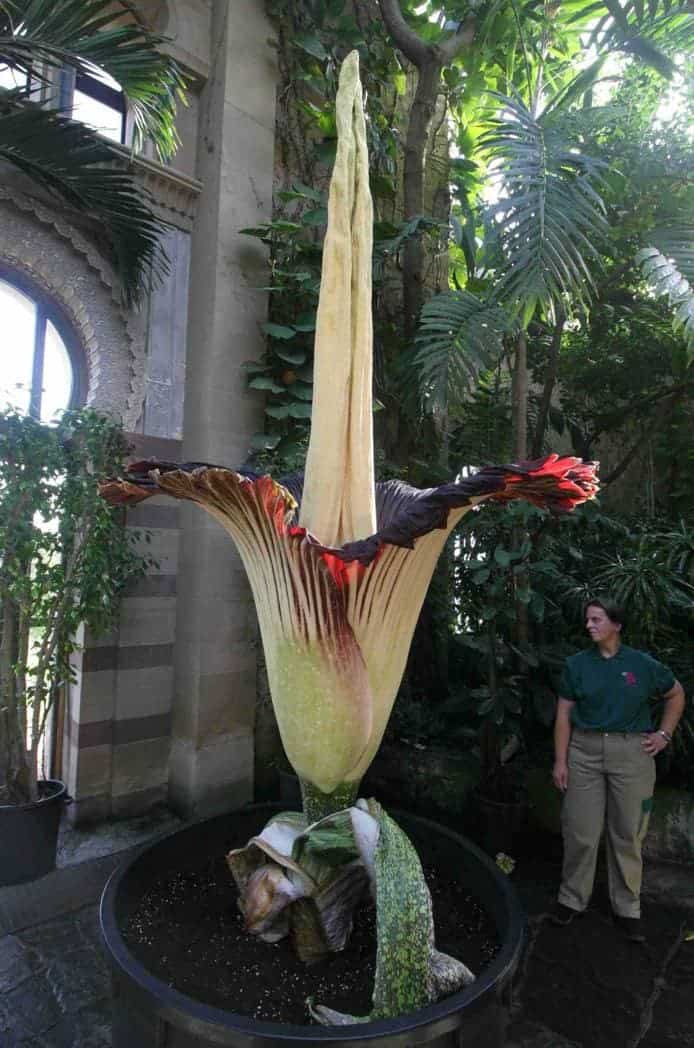Amorphophallus titanum is the full name of this wonder of nature, and a worthy name it is! As with most biological names, it comes from Greek, from amorphos (=without form), phallos (=penis), and titan (=giant). So th name loosely translates as “shapeless titan penis” — gotta love botanists for their creativity.
But there are far more interesting things about this plant than just the name. For starters, just look at what it looks like.

Amorphophallus titanum is a giant flower, and much like the largest one around, Rafflesia arnoldii, emits a scent similar to rotten meat, in order to attract pollinators from as far as possible. For this reason, it is sometimes even called the corpse flower, though it is not the only flower to be called the corpse flower.
To create the volatile compounds that produce the smell, the flower heats up — and for a flower, it heats up quite dramatically. The big, large, yellow-ish component is called a spadix, and the spadix heats up to vaporize the odors and send them even further away. For example, in one experiment, the temperature of the plant was measured to be 24C (75F), and the temperature of the spadix was a whopping 39C (102F).
How does a plant generate this much internal heat? Scientists are still not certain, but it seems that it is using a chemical reaction characteristic of warm-blooded animals.

The flower’s strategy of spreading its smell is very effective. Its inflorescence can reach 3 meters in circumference, weighing 100 kilos or more and this makes it the largest unbranched inflorescence in the world. When it blooms, its scent is so bad you need some heavy resilience to keep your food in your stomach.
But why does it produce this smell?
The titan penis flower blooms very rarely. The period isn’t regular, but it’s somewhere around one bloom per decade. Because it blooms so rarely, it absolutely has to be pollenized and spread its seed. But the titan penis flower isn’t pollenized by bees or butterflies, so it has to rely on other insects for the job: specifically, beetles and flies.
Beetles and flies are drawn to Through a number of ingenious insect traps, these pollinating insects are kept inside to deposit pollen from the female flowers, which open one day before the male flowers. The insects are not devoured, and sooner or later, they escape to pollinate other flowers. The next day, when the male flowers open, the female flowers will already be non-receptive, thus avoiding self-pollination, which can cause a detrimental lack of genetic variance. Many flowers that can self-pollinate have mechanisms to avoid it when they have another option.
The plant thrives in the forested areas of Sumatra, Indonesia, and the Philippines, and was first described scientifically in 1878, by Italian natural scientist Odoardo Beccari. During an exploration of Sumatra, Beccari collected seeds and sent them to Royal Botanic Gardens in Kew, England where he had once studied. The first bloom of this species in cultivation occurred at Kew in 1889.
Since then, several botanical gardens across the world have managed to grow the plan. Technically speaking, if you live in the right climate and care for the plant, you could grow it in your backyard. However, it’s still pretty tricky to care for, and given that it blooms so rarely, it can be quite challenging. The plant generally remains open 24-48 hours and requires numerous months to bloom, which is why there have only been a couple of hundred blossoms recorded, despite the fact that it’s relatively easy to cultivate.
There are dozens of plans in this genus, though not all are as striking and big. They typically produce hundreds of fruits, each containing two seeds. Because it has such a peculiar and vulnerable strategy, is rarely seen in the wild and is considered endangered as its natural habitat is destroyed to make way for agriculture. Conservationists are working to protect this still poorly-understood flower, but this requires local habitat protection.
Also, another interesting fact about it is that it was elected as the official flower of the Bronx in 1939, but was replaced in 2000. Sounds like Bronx’s loss to me.






